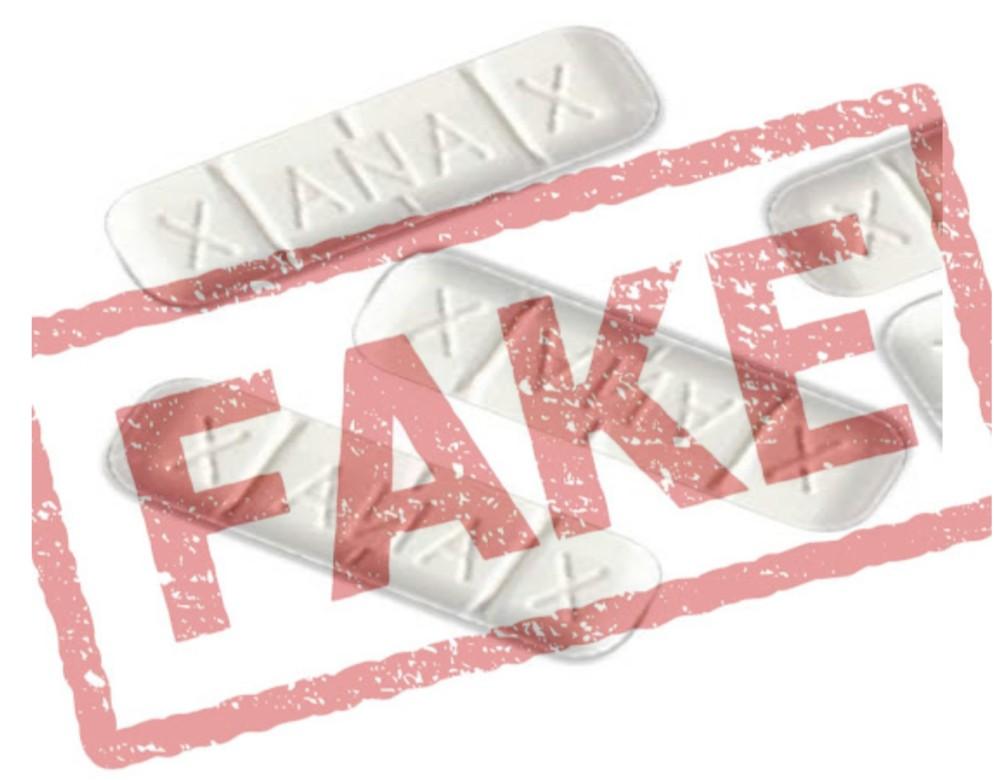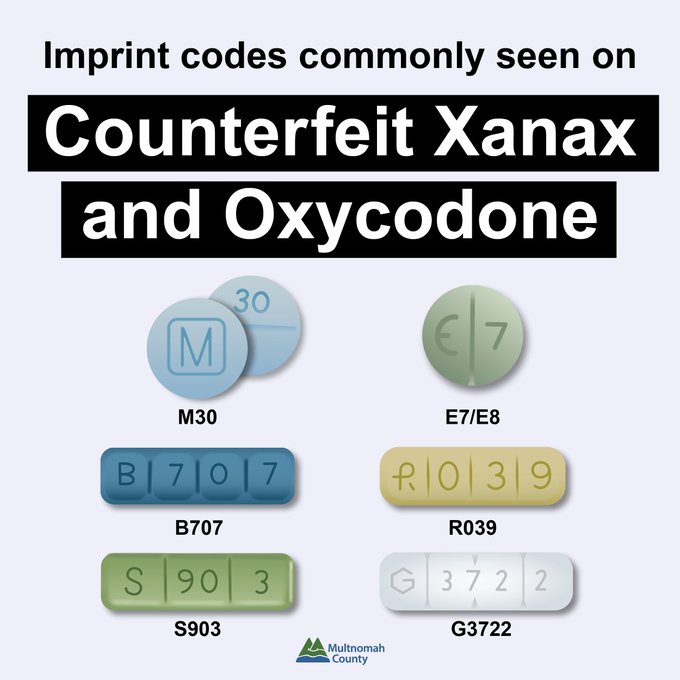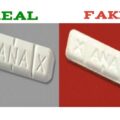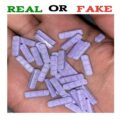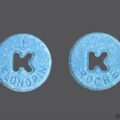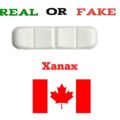Xanax is a prescription medicine used to treat the symptoms of anxiety, panic disorder, and anxiety associated with depression. Xanax may be used alone or with other medications. Xanax belongs to a class of drugs called Antianxiety Agents, Anxiolytics, Benzodiazepines.
A counterfeit or fake Xanax is a medication, substance, or pharmaceutical item which is produced and sold with the intent to deceptively represent its origin, authenticity, or effectiveness. A counterfeit Xanax may contain inappropriate quantities of active ingredients (Alprazolam) or none, may be improperly processed within the body (e.g., absorption by the body), may contain ingredients that are not on the label (which may or may not be harmful), or may be supplied with inaccurate or fake packaging and labeling.
Counterfeit Xanax are a main source of concern for public health because fentanyl-laced Xanax and other pills are responsible for most overdose deaths involving drugs that trigger highs. Fentanyl is a powerful synthetic opioid that is similar to morphine but is 50 to 100 times more potent. Sometimes, fake Xanax pills have been found to also contain etizolam a benzodiazepine analogue from a class of drugs known as thienodiazepines and, like most drugs similar to benzodiazepines.
Some of the most counterfeited types of Xanax include the blue Xanax B707, the yellow Xanax R039, the green Xanax S 90 3, the white Xanax G3722, GG247 Xanax, and the 2090V Xanax. Drug manufacturers and distributors are increasingly investing in countermeasures, such as traceability and authentication technologies, to try to minimize the impact of counterfeit drugs.
What are the dangers of taking counterfeit medicines?
One of the biggest concerns is that you may not be getting the therapeutic benefit you expect from the medicine. For example, a medicine you count on to lower your cholesterol level—or to shrink a cancerous tumor—may not be providing any benefit at all. This is due to the fact that counterfeit medicines have been found to contain less than or more than the required amount of active pharmaceutical ingredients (API) used in the authentic version.
Others have been found to contain the correct amount of API, but have been manufactured in unsanitary, unsafe conditions. There could be a number of harmful ingredients in counterfeit medicines—boric acid, brick dust, talc, and wallboard have been found in counterfeit medicines. Some have also been found to contain opioids, which can be deadly if combined with benzodiazepines, like XANAX. A counterfeit medicine could also interact with other medications you’re taking and create potential health issues.
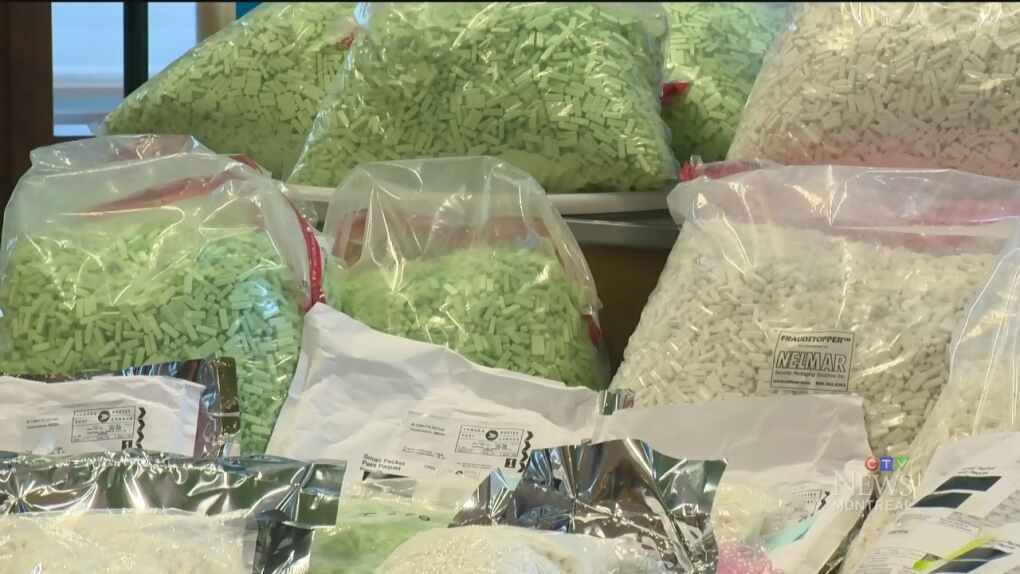
How do you know if/when you’ve purchased a counterfeit medicine?
In some cases, patients have noticed a different taste, consistency, or appearance of medicines that are later identified as being counterfeit, or they may have a different reaction to the counterfeit drug.
However, in more cases, many consumers may not know that the medicines they’ve purchased are counterfeits. That’s why it’s important to purchase prescription medicine from a legitimate pharmacy and pharmacist with whom you are familiar.
Why is it dangerous to order medicines from uncertified online sources?
The danger in ordering medicines from uncertified online sources is the complete lack of transparency as to the true location of the “pharmacy” and the source and authenticity of the medicines they dispense — In the U.S., patients can safely fill prescriptions from an online pharmacy certified by the National Association of Boards of Pharmacy (NABP).
NABP’s Verified Internet Pharmacy Practice Sites (VIPPS®) program only certifies pharmacies that meet state licensing and inspection requirements. To find a VIPPS certified pharmacy, patients should refer to the list posted to the NABP (https://nabp.pharmacy) or VIPPS (https://nabp.pharmacy/programs/vipps) websites
While medicines can safely be purchased from those pharmacies that are licensed and registered, the vast majority are no more than convincing “shells.” In their latest report on fake online pharmacies that ply their trade in the United States, the National Association of Boards of Pharmacy (NABP) found more than 1,500 new websites that it considers “Not Recommended,” and of these, 31% are offering illicit prescription drugs, such as fentanyl,. Falsified medicines are often the business of criminal cartels.
Xanax as a street drug
Xanax is one of the most widely prescribed benzodiazepines for the treatment of generalized anxiety disorder and panic disorder. Its clinical use has been a point of contention as most addiction specialists consider it to be highly addictive, given its unique psychodynamic properties which limit its clinical usefulness, whereas many primary care physicians continue to prescribe it for longer periods than recommended.
Although it has allowed many individuals to regain control of their anxiety and their life, it has also become a widely used and abused addictive drug. Xanax works within minutes of entering the bloodstream and peaks within hours and results in a state of pleasure and euphoria and as a result, many individuals use this drug for recreational purposes rather than medical purposes. Due to the recreational popularity of this drug, Xanax is a well-known street drug that is often used to enhance the effects of alcohol in social situations such as parties and concerts. Xanax abuse can elicit pleasurable effects such as lightheadedness, a sense of unreality, a feeling of detachment, emotional numbness, and a greater sexual inclination.
Facts about Xanax
- 55 percent of nonmedical users acquired prescription painkillers (including Xanax) for free from a friend or relative.
- 17.3 percent abused medications that were prescribed by their own doctor.
- 11.4 percent bought them from a friend or relative.
- 4.8 percent sneaked from a friend or relative.
- Whereas only 4.4 percent bought them from a dealer.
- Seventy percent of teenagers battling a Xanax addiction acquired the drug from their family’s medicine cabinet.
- Emergency room visits owing to recreational abuse of Xanax escalated from 57,419 in 2005 to 124,902 in 2010.
- In 2013, 50 million prescriptions were written for Xanax, an increase from 38 million prescriptions in 2006.
- Prescription rates for Xanax have been at a steady increase of 9 percent rate since 2008.


